Calcata: A hill town in the clouds is a perfect artist’s landscape
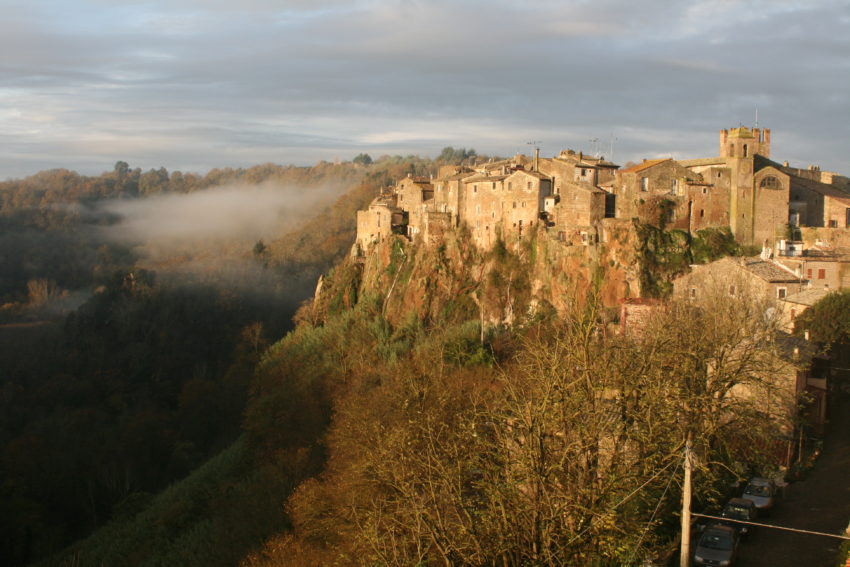
DEC. 9
CALCATA, Italy — Hill towns are spread out around Italy like spilled gum drops. Drive along the autostrada and inevitably, out in the distance, you’ll see a cluster of buildings high in the sky surrounded by a wall. They look like something out of the Sir Galahad and Medieval Europe. The Moody Blues’ “(K)Nights in White Satin” will mysteriously come to mind. It’s not far off. When the Roman Empire fell in the fifth century, every surrounding band of marauders stormed Italy to extract their revenge. The Goths. The Vandals. The Lombards. Manchester United. Everyone within striking distance of the Italian peninsula came calling, swinging axes and lopping off heads for centuries to come.
To fend off attacks, people built homes atop hills and surrounded them with walls. Those walls and towns still exist. You can find them all over Central Italy. Siena. Assisi. Orvieto. My favorite, however, won’t be found in Lonely Planet yet it’s only 30 miles north of Rome.

I’ve written this before and I remind myself of it every time I visit. The village of Calcata is so cute it belongs on a cat calendar. It is not just on a hill. It’s on a cliff. It is perched precariously on a towering 150-foot pile of volcanic rock like a movie set for a town in space from the 22nd century. But this area has been inhabited for 3,000 years. Today it has fewer people than your average college football roster. The population sits at 70. Add one more and they may get squeezed off the cliff and plunge to the lush countryside below. Of the 70, it’s believed 69 are artists. The other one, apparently, picks up discarded paint brushes, chipped marble and broken glass.
In two stints living in Rome, I’ve visited Calcata four times. The experiences form a continuous loop in my mind when I think of the true Italy: Sitting at the end of a tiny alley, looking out over the cliff, talking to two long-haired artists who had dropped out of Rome’s rat race; munching paninos in a tiny but warm tea shop on a shivering cold winter morning; seeing the fresco Jimi Hendrix painted on an 18th century building; discussing life with a musician from his perch on a balcony overlooking Calcata’s tiny piazza; a congregation of purring cats rubbing against me in one of the town’s many dark corridors illuminated only by moonlight creeping through the roofs; waking up and looking DOWN at fog settling just below the treeline.

It’s not hard to reach Calcata. You take Rome’s subway to the Flaminio stop in the north part of the city. Exit the station and enter the adjacent Roma-Viterbo train station. Take it 12 minutes to the Rome neighborhood of Saxa Rubra then a bus 50 minutes, through countryside that was once the setting for Spaghetti Westerns in the ‘60s, to just outside Calcata’s wall. This time, however, I went a step further. For the first time, I spent the night.
I tell visitors to Italy go ahead and visit the tourist traps. But do this: Stay overnight. These towns change. Positano, Assisi, Cortona. At night, the tourists are back in their hotel bases in Rome or Florence and the locals come out. Calcata is the same way. The only difference is there aren’t many locals.

In December, Calcata is about a dozen pulses away from a ghost town. Greeting me just outside the arched gate was Gisa Federici, a beaming, curly haired local who led me to the apartment. Gisa has the kind of friendly, open-minded air of a woman who lives among artists high in the clouds. Originally from Bologna, she and her husband moved to Calcata 20 years ago because, she wrote me in an email (gisa.federici@libero.it), “It is paradise. For nothing in the world would I change it with another town or city.”
The apartment is just past the piazza up a few dark steps. Inside it was as rustic as a log cabin in the woods. Space heaters warmed the rooms as temperatures quickly dropped into the 40s. Surrounding fog made Calcata even colder, like shroud that falls over London after a rain. But Calcata’s quaintness, how everyone is tightly packed atop this precipice, made it seem oddly warm.
Touring Calcata takes all of about 15 minutes. Walk past the pub sign of Il Graal with the gold chalise, look inside at the cozy surroundings of Opera l’Arte del Gusto restaurant, see the few outdoor seats for A.C. Live Rock Cafe, one of the smallest bars in Italy but with one of the best views. One merchant put up a sign that read, in Italian, “I’m at lunch. If I’m not drunk, I’ll reopen at 3 p.m.” Young women redecorated window displays. Potted plants hung from nearly every gated balcony in town.
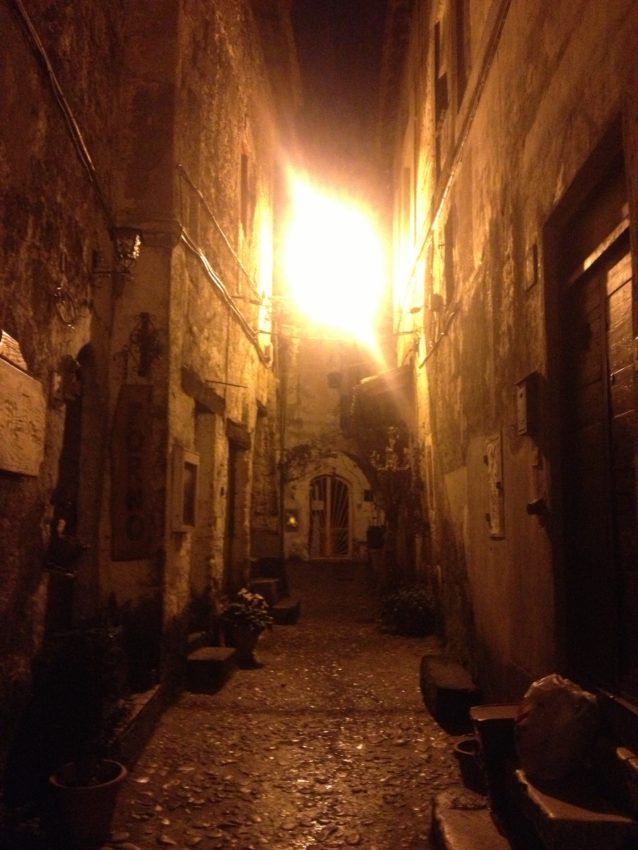
Kudos for the artists for making Calcata out of nothing, like painting a masterpiece on a blank canvas. In the 1930s, Benito Mussolini condemned Calcata in fear its crumbling foundation would be a danger to his fascist followers. By the 1960s, Calcata had been abandoned and left to rot like an old bird’s nest. In the 1970s, however, Italian artists and hippies started squatting in the abandoned houses and caves. Soon, they convinced Italian authorities to reverse its condemnation of the town.
In the summer it bristles with galleries, cafes and tea shops. But on this December weekday one restaurant was open. One. Fortunately, this is Italy. I knew it would be good. This isn’t like one restaurant open in Big Piney, Wyo. Ristorante 3 Monti is right outside the town wall. It’s two small rooms with red-and-white checked tablecloths and black and white photos of famous Italian movie scenes on the walls. Wine bottles from the local Lazio region stood on shelves made the room seem as warm as the roaring fireplace.
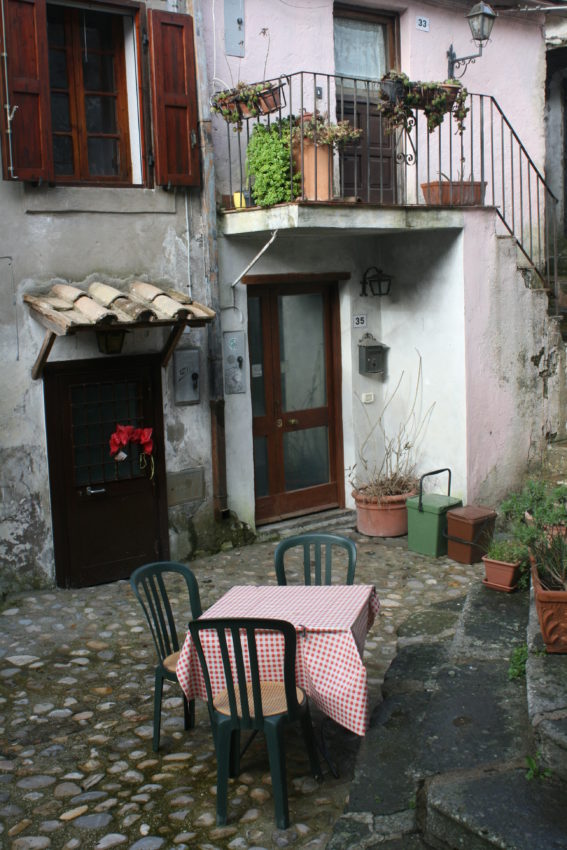

The food at 3 Monti takes country dining to a new level. At lunch, a mixed bruschetta featured thick slices of homemade bread, dripped in local olive oil and covered in either prosciutto, tomatoes, mozzarella or eggplant. Following that came a steaming plate of strozzapreti, the short, round, twisted pasta so named, legend has it, because ravenous priests would so gorge themselves on the savory pasta they choked to death. It is that good. However, the way they mixed it with local mushrooms and sweet, lean Italian sausage, I was in no hurry to finish.
I had no problems with returning for dinner. Who could when the owner himself served a big plate of cinghiale stew. This area of the Lazio region is crawling with wild boar. On a recent hike in the area, I saw hunters in bright orange vests and guns the size of sculling oars perched on country roads waiting for the tusked pigs to appear. One of them may have been represented by the fat, juicy chunks of meat on a wooden cutting board. The owner, Adolfino, is heavy and rough looking, like a mob hit man who’d retired to the kitchen. But his smile and jolly laughter as he handed me the cinghiale made me feel as if I was a local, just like the growing crowd of elderly and artists.
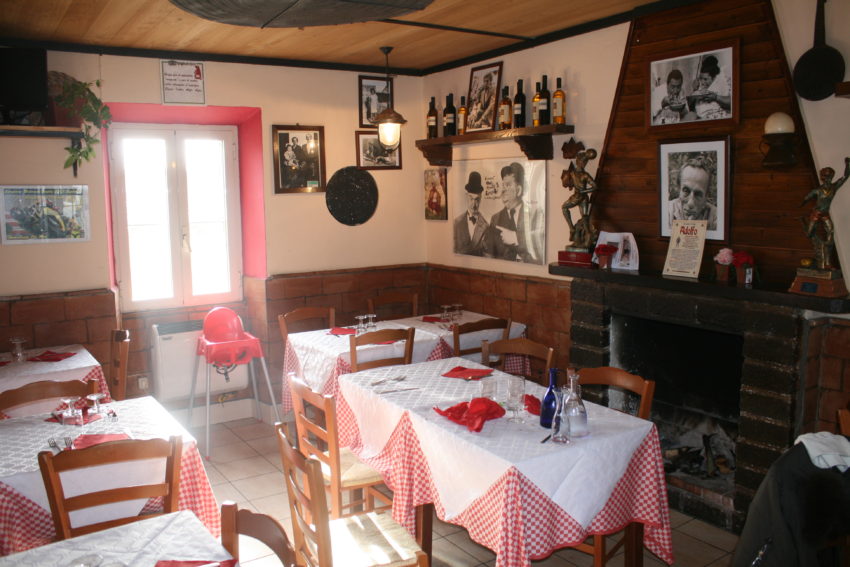
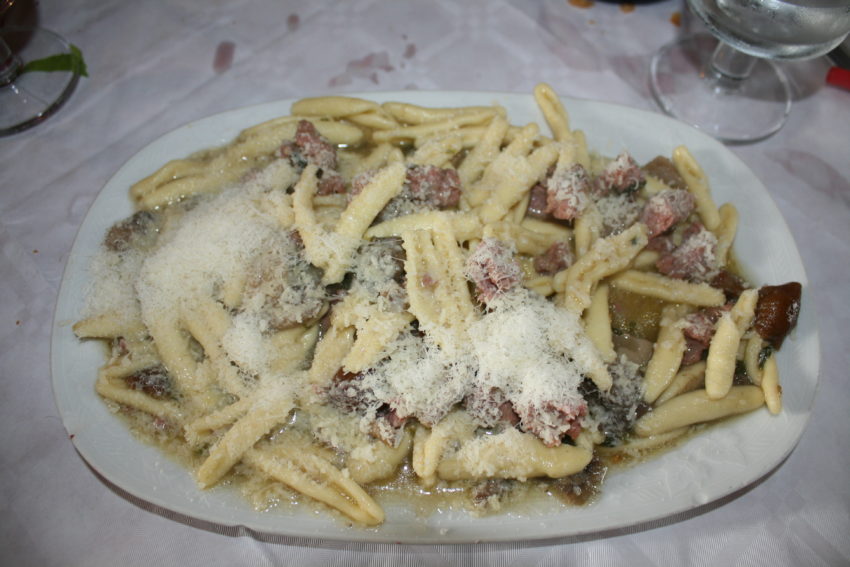
“‘Mazza che bono!” I said in the Romanesco dialect for “This is SO good!” He slapped me on the back and laughed, as if officially accepting me to his little hamlet.
Life in Calcata doesn’t get much better than that. It doesn’t have to. While nearby Rome is going bankrupt, while Italy undergoes its third recession in six years and unemployment in the country tops 13 percent, little Calcata stays high above the fray. As I woke up the next morning and saw the familiar clouds hovering below, I felt the draw that brought artists here for inspiration. These walls may have kept the Vandals out.
But not me.


December 11, 2014 @ 9:24 am
Fabulous. I would so rather be in Italy than anywhere else. You are damn lucky John.
December 11, 2014 @ 10:12 am
Thanks, Chandi. Wait’ll you read about my seven-course feast in Umbria.